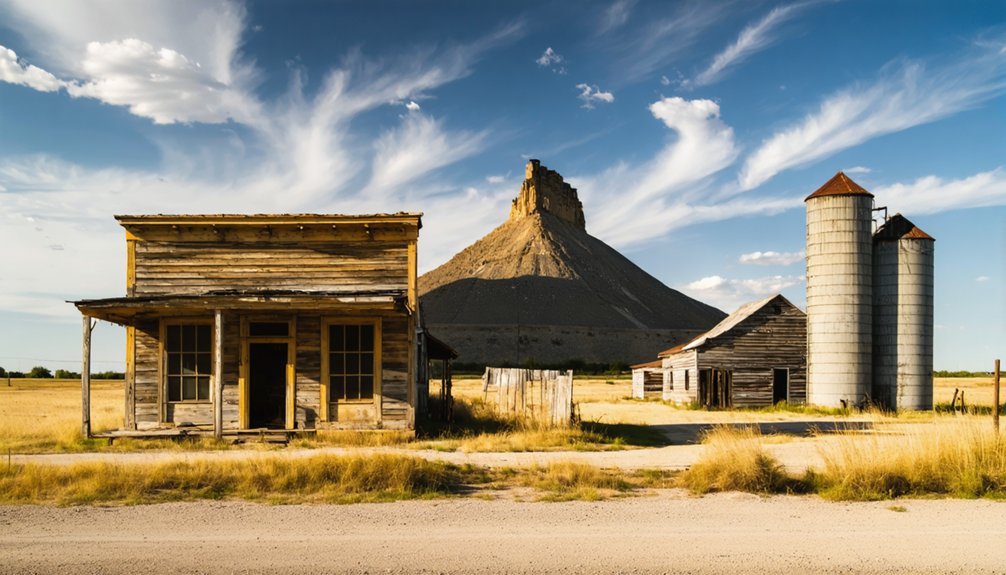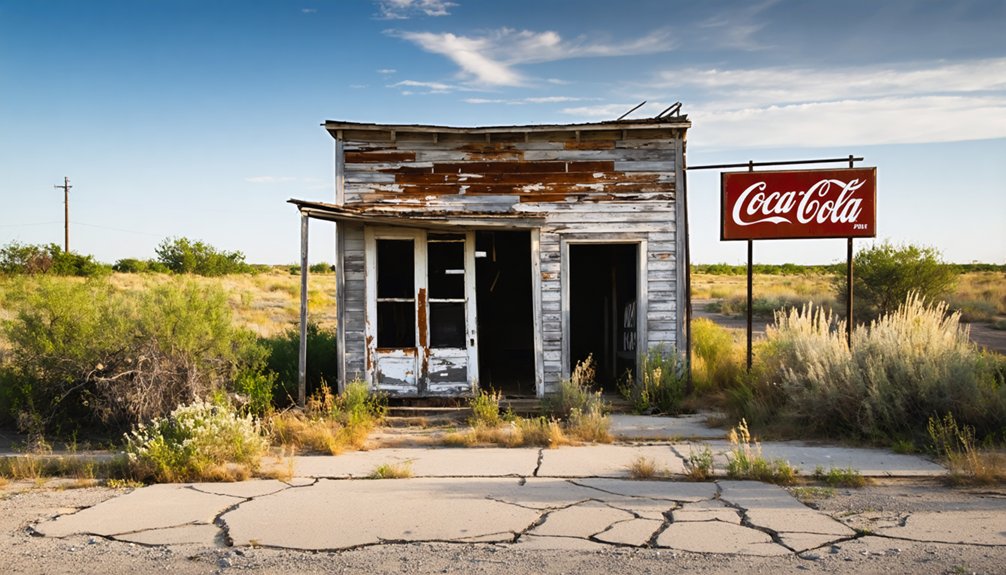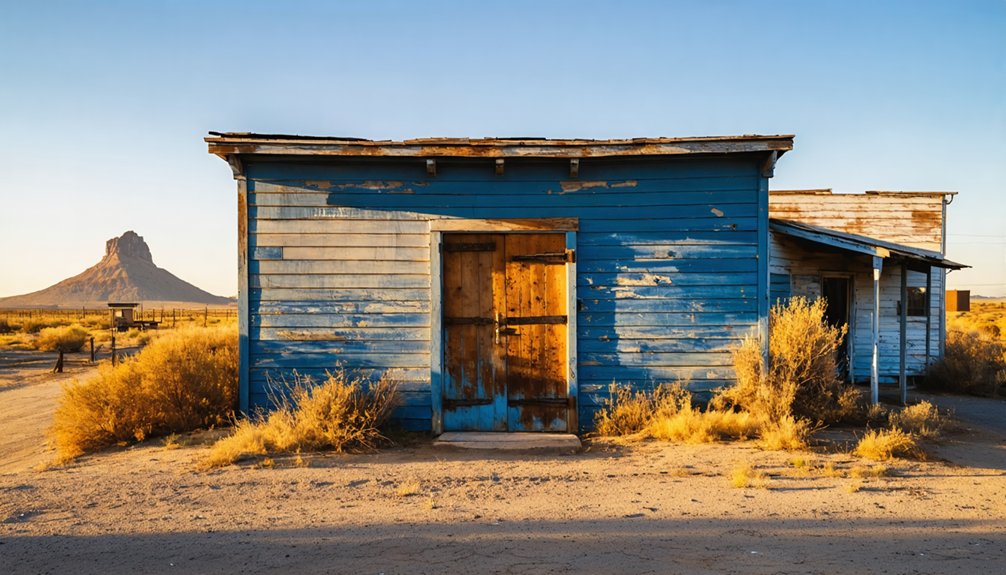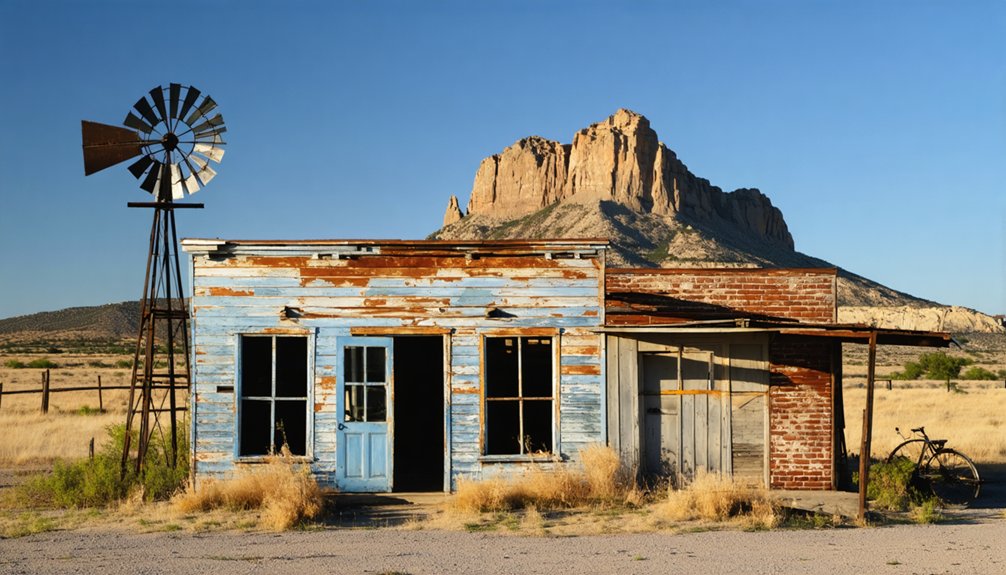You’ll find Medicine Mound, Texas nestled among four sacred dolomite hills that rise dramatically to 1,744 feet above the North Texas plains. Once a thriving pioneer settlement with unique cobblestone buildings, the town declined after a devastating fire in 1933 destroyed most structures and essential records. Today, this ghost town preserves both pioneer history and Native American heritage, with the Medicine Mounds still serving as sacred ceremonial grounds for Comanche Nation members. The site’s remaining structures hold countless untold stories of prosperity, tragedy, and spiritual significance.
Key Takeaways
- Medicine Mound became a ghost town after a devastating fire in 1933 destroyed most buildings and vital financial records.
- The town’s abandonment was accelerated by the Great Depression, a severe 1938 snowstorm, and the discontinuation of railroad service.
- Only two original buildings survived the 1933 fire, with the bank vault’s collapse erasing crucial property and financial documentation.
- The closure of the local school in 1955 marked the final end of organized community life in Medicine Mound.
- Today, the site features the Medicine Mound Museum and preserves four sacred dolomite hills important to Comanche spiritual traditions.
Origins of a Sacred Settlement
Rising majestically from the southeastern plains of Hardeman County, Texas, the Medicine Mounds stand as four distinctive dolomite hills that reach heights of 200 to 350 feet above the surrounding landscape.
You’ll find these sacred landscapes crowned by the highest peak at 1,744 feet, where the Comanche believed powerful spirits dwelled on its flat summit.
These geological formations, remnants of an ancient ocean floor, became central to indigenous practices. The Comanche used the mounds for spiritual ceremonies, vision quests, and the preparation of medicinal herbs. The descendants of Chief Quanah Parker continue to perform sacred blessings at these sites.
Natural springs at the base of the Big Mound provided essential water resources, while the surrounding plains offered rich hunting grounds for bison. A privately-owned cattle ranch now encompasses these historic mounds within its 20,000-acre expanse.
Even today, Native Americans continue their annual pilgrimages to honor these spiritually significant sites.
The Medicine Mounds Legacy
You’ll find the Medicine Mounds still serve as sacred ceremonial grounds where Comanche Nation members return annually for spiritual practices and vision quests.
These four dolomite hills, rising to 1,700 feet above the Texas plains, continue to draw visitors who respect their dual significance as both geological landmarks and Native American spiritual sites.
The preservation efforts of local ranchers and the Medicine Mound Museum help maintain this cultural legacy, while promoting responsible tourism that honors the mounds’ historical importance to indigenous peoples.
Visitors can see the unique architecture of the town’s remaining structures built with round cobble stones collected from the nearby Wichita Mountains.
The site’s history took a dark turn when Ella Tidmore burned the once-thriving town in 1933, forever changing the landscape of this historic area.
Sacred Native American Sites
The four Medicine Mounds of southeastern Hardeman County, Texas stand as enduring monuments to Comanche spiritual heritage, with the largest peak reaching 1,744 feet above sea level.
You’ll find these conical hills rising dramatically above cotton and grain fields, their dolomite cores untouched by modern development.
For the Comanche people, these mounds weren’t just landmarks – they were centers of sacred rituals and indigenous healing.
On Big Medicine Mound, warriors would set out on four-day vision quests, while medicine men gathered herbs believed to be empowered by the peak’s benevolent spirit.
A natural spring and cottonwood grove at the base provided essential resources for both practical and ceremonial needs.
Even today, these ancient sites remain protected by their rugged terrain, preserving their connection to Native American spirituality. According to Wallace and Hoebel, the Medicine Mounds held profound significance in Comanche cultural practices. The mounds’ sacredness is highlighted by the presence of redberry cedar, a plant traditionally used in healing ceremonies.
Historical Spiritual Significance Today
While modern development has transformed much of Texas’s landscape, Medicine Mounds remains an essential spiritual sanctuary where Comanche descendants continue their ancestral practices.
You’ll find that these sacred dolomite formations, particularly the flat-topped highest peak, serve as a powerful connection point between the physical and spiritual worlds.
The site’s indigenous healing traditions persist through vision quests and spiritual rituals, where Native Americans gather to use medicinal plants and natural springs for guidance and restoration.
Today, Medicine Mounds Ranch’s private ownership supports the preservation of these sacred grounds while allowing tribal members to maintain their spiritual connection. The Great Depression and a devastating fire in the 1930s nearly erased the town, yet its spiritual significance endured.
Local museums and cultural programs now emphasize respectful engagement with the site’s legacy, recognizing its role as a rare, intact spiritual landscape amid Texas’s agricultural transformation.
Preservation and Cultural Tourism
Since its decline as a thriving agricultural center, Medicine Mound has evolved into a carefully preserved heritage site anchored by two iconic cobblestone buildings and a downtown museum that safeguards pioneer artifacts, photographs, and settler stories.
You’ll find tourism strategies seamlessly blending pioneer and Native American cultural narratives through restored buildings, museum exhibits, and the sacred Medicine Mounds themselves. Jeanene Stermer, the museum’s dedicated curator, has collected thousands of donated items that tell the town’s rich history.
The 20,000-acre Medicine Mounds Ranch, established in 2012, protects these landmarks while operating as a working cattle operation. You can explore the schoolhouse ruins, visit the relocated train depot in nearby Quanah, or stay in historic Airbnb rentals.
Annual Native American ceremonies at the mounds and partnerships between ranch owners, local governments, and residents keep the area’s rich heritage alive while stimulating cultural tourism and community revitalization.
Railroad Boom Years
After establishing a townsite in 1908, Medicine Mound experienced rapid growth following the arrival of the Kansas City, Mexico and Orient Railway.
You’d have seen the town relocate 2.5 miles north to align with the railroad’s route, positioning itself for the economic opportunities that rail access would bring.
The railroad expansion transformed this small community into a bustling rural center. Like the nearby Santa Fe Station, the depot served as a vital transportation hub for both passengers and freight.
By 1929, you’d have found 22 thriving businesses serving roughly 500 residents. The economic impact was undeniable – the town boasted grocery stores, dry goods shops, barber shops, and even its own newspaper, the Citizen.
The railway’s passenger and freight services made Medicine Mound a crucial hub for agricultural commerce and trade, connecting local farmers and merchants to broader markets throughout the region. A devastating fire in 1933 marked the beginning of the town’s decline.
Peak of Pioneer Prosperity

The early 1920s marked Medicine Mound’s golden age of pioneer prosperity, building on the momentum of its railroad-driven expansion.
You’d have found a bustling town of 500 residents, with 22 thriving businesses serving the local farming community. The town’s agricultural practices centered on cotton, sorghum, and wheat production for national markets, while cattle ranching dominated the rougher terrain to the south and west.
During this peak, you could’ve visited the local bank, eaten at the restaurant, or caught up on community news in The Citizen newspaper.
The level, productive farmland northeast of town supported a vibrant agricultural economy. While the economic decline hadn’t yet begun, Medicine Mound’s prosperity would eventually fade with the onset of the Great Depression and a devastating 1932 fire.
The Great Fire of 1933
You’ll find that Medicine Mound’s most devastating event began at 3:00 a.m. on March 31, 1933, when Ella Tidmore set fire to a barber shop during a bout of mental illness.
Strong south winds spread the flames through the town’s wooden structures, leaving only two buildings standing amid the destruction.
The bank vault’s collapse during the inferno destroyed all of Medicine Mound’s financial and municipal records, erasing essential historical documents forever.
Fire’s Devastating Path
During the early morning hours of March 31, 1933, Medicine Mound faced its most catastrophic event when mentally ill resident Ella Tidmore set fire to the local barber shop using her husband’s trousers as fuel.
As fierce south winds whipped through town, you’d have seen the flames rapidly consume nearly every building in their path, leaving only two businesses standing in the fire’s aftermath.
The destruction proved overwhelming – the bank vault collapsed, destroying all financial records, while wooden structures burned to the ground.
Despite attempts at community resilience, the fire marked a turning point from which Medicine Mound would never recover.
Most telling was Ella Tidmore’s response to the devastation she’d caused – she stood on her lawn, laughing as she watched her town burn.
Lost Bank Records Forever
Among the most devastating consequences of Medicine Mound’s 1933 fire was the complete destruction of its bank vault, which housed every financial record in town.
The vault’s collapse during the blaze erased essential documentation of the community’s economic history, leaving an irreparable void in understanding the town’s financial past.
The lost records’ economic impact was particularly severe due to:
- Complete destruction of all banking transactions, loans, and deposit records
- Loss of pivotal town deeds and tax documentation
- Inability to verify property ownership and business dealings
- Disruption of financial recovery efforts during the Great Depression
You’ll find that without these fundamental records, Medicine Mound’s decline accelerated rapidly.
The town, already struggling through the Depression, couldn’t rebuild its institutional framework, contributing to its eventual transformation into a ghost town.
Path to Abandonment

Medicine Mound’s path to abandonment began with a catastrophic fire in 1933 that destroyed most of the town, including its crucial bank vault and financial records.
You can trace the economic decline through a series of devastating blows: an extreme snowstorm in 1938 that crippled recovery efforts, the Great Depression‘s lingering effects, and World War II’s drain on the local population.
The community loss accelerated when the railroad service ended, removing a critical lifeline for the town’s commerce and connectivity.
When the trains stopped running, Medicine Mound lost more than transportation – it lost its connection to the outside world.
By the 1950s, you’d have witnessed the final signs of defeat – the school’s closure in 1955 marked the end of organized community life.
The industrialization boom drew remaining residents to larger cities, leaving Medicine Mound’s stone structures as silent witnesses to its once-vibrant past.
Preserving Historical Heritage
Preserving historical heritage at Medicine Mound thrives through a multifaceted collaboration between Native American tribes, local ranch owners, and dedicated historians.
You’ll find a deep commitment to cultural preservation across the site, where the Comanche Nation continues their spiritual traditions through annual ceremonies and vision quests.
The historical significance of Medicine Mound is maintained through:
- Restoration of original cobblestone structures using authentic materials and techniques
- Documentation of pioneer family histories and agricultural heritage at the Downtown Museum
- Integration of heritage tourism with sustainable ranching practices
- Protection of sacred Native American sites through coordinated preservation efforts
You’re welcome to experience this living history through heritage tours, cultural events, and restored buildings that now serve as museums and lodging, all contributing to the area’s economic revitalization.
Visiting the Ghost Town Today

Planning a visit to this historic ghost town starts with understanding its remote location in Hardeman County, Texas, approximately 12 miles southeast of Quanah.
You’ll find it via Farm to Market Road 1167, with GPS coordinates helping guide your ghost town exploration.
During your visit, you can explore the Downtown Medicine Mound Museum, which showcases local farm and ranch life exhibits.
Step inside the Downtown Medicine Mound Museum to discover authentic artifacts and exhibits celebrating the region’s rich agricultural heritage.
The site’s local attractions include remaining stone buildings, the Stermer homestead, and the spiritually significant Medicine Mounds.
While most original structures were lost to a 1932 fire, several restored buildings offer glimpses into the past.
Remember to bring supplies and water, as amenities are limited.
For the best experience, plan your visit during spring or fall when weather conditions are mild.
Frequently Asked Questions
Are There Any Documented Ghost Sightings or Paranormal Activity in Medicine Mound?
You won’t find any verified ghost encounters or documented paranormal investigations at this site. Historical records show no confirmed sightings, and ghost hunters haven’t produced evidence of supernatural activity here.
What Happened to the Residents After the Town Was Abandoned?
By 1955, with the school’s closure forcing the last families out, you’ll find residents’ fate led them to nearby towns like Quanah and Chillicothe, while maintaining their town legacy through museums.
Can Visitors Climb or Explore the Sacred Medicine Mounds Today?
You can’t freely climb or explore the sacred site today. The Medicine Mounds are privately owned, with visitor restrictions requiring explicit permission from ranch owners and respecting Comanche spiritual traditions.
Which Original Cobblestone Buildings Are Still Standing and Accessible to Visitors?
Sunlight gleams off rounded stones as you’ll find two historic cobblestone buildings: the Downtown Medicine Mound Museum (former Hicks & Cobb store) and another original structure, both freely accessible for your exploration.
When Was the Last Permanent Resident Recorded Living in Medicine Mound?
You’ll find the last resident of this town’s history departed in the early 1960s, with Ira Lee Hicks’s death in 1966 marking one of the final indicators of any permanent inhabitants.
References
- https://adventuresofthecrazytrain.com/2014/12/04/the-town-of-medicine-mound-texas-population-0/
- https://www.redriverhistorian.com/post/long-gone-medicine-mound-texas
- https://medicinemoundsranch.com/about/
- https://jollyoutlaw.com/2024/11/medicine-mound-ghost-town/
- https://www.texasescapes.com/TexasTowns/Medicine-Mound-Texas-Favorite-Detour.htm
- https://www.youtube.com/watch?v=NdZOFY-u2AQ
- https://www.texasescapes.com/TexasTowns/Medicine-Mound-Texas.htm
- https://www.bonesoftexas.com/medicine-mound
- https://landingaday.wordpress.com/2024/10/15/quanah-and-medicine-mound-texas/
- https://www.tshaonline.org/handbook/entries/medicine-mounds



